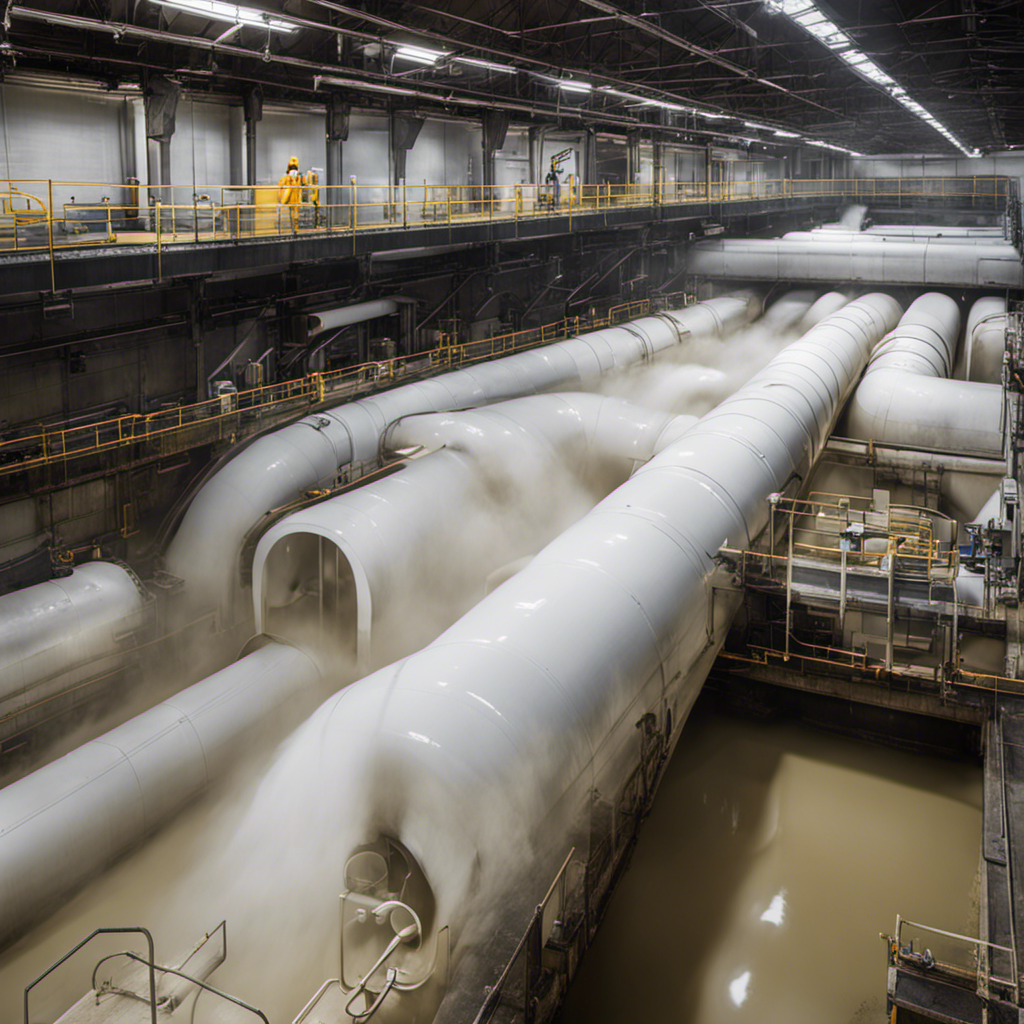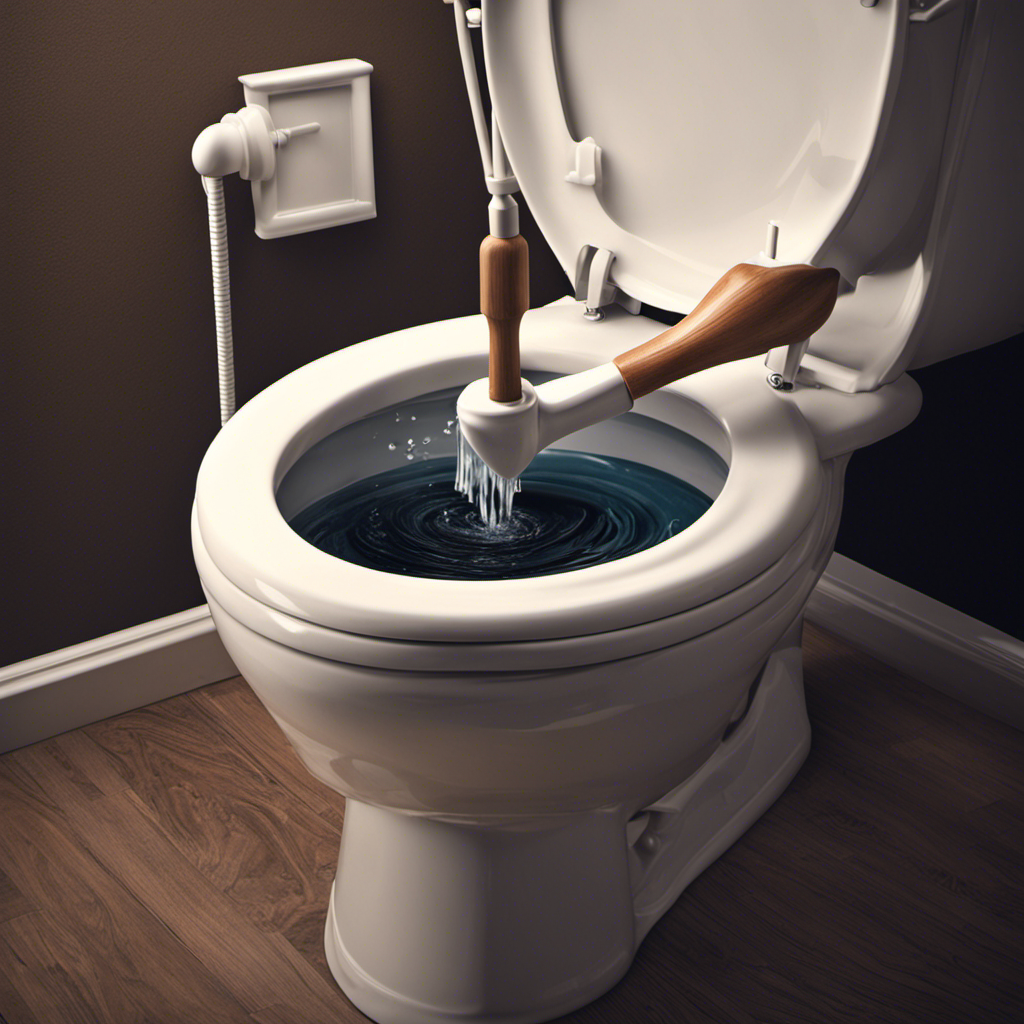Ever wondered where your waste goes once you flush the toilet? Well, buckle up because I’m about to take you on a wild ride through the world of sewage.
When you press that magical button, gravity does its thing, propelling your waste through a complex network of pipes. But that’s just the beginning.
In this article, we’ll dive into the fascinating world of municipal wastewater treatment, explore the importance of proper sewer maintenance, and discuss sustainable solutions for managing human waste.
So, hold your nose and prepare to be amazed!
Key Takeaways
- Waste travels through pipes and enters the sewer system.
- Gravity plays a crucial role in guiding waste towards the municipal wastewater treatment plant.
- The municipal wastewater treatment process involves preliminary, primary, secondary, and tertiary treatments to remove impurities and pathogens.
- Proper sewer maintenance and infrastructure upgrades are essential to safeguard public health and prevent costly repairs.
The Journey From Toilet to Sewer System
When you flush the toilet, the waste travels through the pipes and enters the sewer system. This process is a result of the ingenious indoor plumbing system that has evolved over centuries.
The history of indoor plumbing dates back to ancient civilizations such as the Indus Valley and ancient Rome, where the concept of channeling waste away from living spaces was first implemented.
Today, water conservation strategies in the bathroom play a crucial role in reducing the environmental impact of wastewater disposal. Low-flow toilets, for example, use less water per flush compared to traditional toilets, saving gallons of water each day.
Similarly, installing aerators on faucets reduces water usage without compromising functionality. By implementing these strategies, we can ensure that waste is properly disposed of while conserving water resources.
Understanding the Role of Gravity in Waste Disposal
Gravity plays a crucial role in disposing of waste after you flush. When you flush the toilet, gravity’s impact comes into play, causing the wastewater and waste materials to flow down the drain and into the sewer system. The force of gravity pulls the waste downwards, creating a natural waste disposal mechanism.
As the wastewater and waste materials flow through the pipes, they are guided by the force of gravity towards the municipal wastewater treatment plant. This process ensures that the waste is efficiently transported away from residential and commercial areas.
Understanding the role of gravity in waste disposal is essential to appreciate the importance of a properly functioning sewer system in maintaining public health and hygiene.
Now, let’s explore the municipal wastewater treatment process.
Exploring the Municipal Wastewater Treatment Process
To understand the municipal wastewater treatment process, you’ll need to know the steps involved in treating and purifying wastewater. Here are the key steps:
-
Preliminary Treatment: Large debris and solids are removed through screening and grit removal to protect equipment downstream.
-
Primary Treatment: Wastewater flows into large settling tanks, allowing solids to settle to the bottom as sludge.
-
Secondary Treatment: Bacteria and microorganisms are introduced to the wastewater, breaking down organic matter through aeration or biological processes.
-
Tertiary Treatment: Advanced treatment methods like filtration and disinfection are employed to remove remaining impurities and pathogens.
Water purification methods used in wastewater treatment include physical, chemical, and biological processes. While these processes effectively remove contaminants and protect public health, they can also have environmental impacts.
Excessive nutrients, like nitrogen and phosphorus, can be released back into water bodies, leading to eutrophication and harming aquatic life.
Understanding the municipal wastewater treatment process is crucial for recognizing the importance of proper sewer maintenance and infrastructure.
The Importance of Proper Sewer Maintenance and Infrastructure
Proper sewer maintenance and infrastructure are essential for preventing costly repairs and ensuring the efficient transportation of wastewater.
Neglecting sewer systems can have severe public health implications and significant economic impacts. When sewers are not properly maintained, they can become clogged or damaged, leading to sewer backups and overflows. These incidents can result in the release of untreated wastewater into the environment, posing a threat to public health by contaminating water sources and spreading waterborne diseases.
Additionally, repairing and cleaning up after such incidents can be extremely expensive, burdening municipalities and taxpayers with significant costs. By investing in regular maintenance and upgrading aging infrastructure, communities can safeguard public health, protect the environment, and avoid the high economic costs associated with sewer system failures.
Sustainable Solutions for Managing and Treating Human Waste
By implementing sustainable practices, communities can effectively manage and treat human waste, ensuring a healthier environment and reducing the strain on existing infrastructure. Here are four innovative solutions for managing and treating human waste:
-
Waste to Energy Conversion: Advanced technologies are being developed to convert human waste into energy. This process involves harnessing the energy potential of waste through anaerobic digestion or thermal treatment, reducing the reliance on fossil fuels and promoting a circular economy.
-
Community-Based Composting Initiatives: Composting toilets and community composting programs offer an eco-friendly alternative to traditional sewage systems. Organic waste is transformed into nutrient-rich compost, which can be used to enrich soil and support sustainable agriculture.
-
Resource Recovery: Innovative techniques aim to recover valuable resources from human waste, such as phosphorus and nitrogen, which can be used as fertilizers or in industrial processes, reducing the need for chemical inputs.
-
Decentralized Treatment Systems: Moving away from centralized sewage systems, decentralized treatment systems offer localized solutions that can be tailored to the specific needs of communities. These systems utilize natural processes like filtration and biological treatment to effectively treat and manage human waste.
Frequently Asked Questions
What Are the Potential Health Risks Associated With Improper Sewer Maintenance and Infrastructure?
There are potential health risks associated with improper sewer maintenance. Issues such as sewage backups and leaks can expose people to harmful pathogens and toxins, leading to illnesses and infections. Regular maintenance is crucial to prevent these risks.
How Does the Municipal Wastewater Treatment Process Differ in Rural Areas Compared to Urban Areas?
In rural areas, the municipal wastewater treatment process may differ from urban areas due to limited resources and infrastructure. This can have a significant impact on water quality and the ability to properly treat and dispose of waste.
Are There Any Environmentally-Friendly Alternatives to the Traditional Sewage Treatment Methods Mentioned in the Article?
There are environmentally-friendly alternatives to traditional sewage treatment methods, such as sustainable sanitation systems. These systems aim to minimize water usage, recycle waste materials, and promote the use of natural and eco-friendly processes.
What Happens to the Waste That Is Disposed of in Septic Tanks or Other Private Sewage Systems?
When waste is disposed of in septic tanks or other private sewage systems, it undergoes a process called septic tank maintenance. If not properly maintained, it can lead to sewage system contamination, posing health and environmental risks.
Is There a Global Standard for Managing and Treating Human Waste, or Do Different Countries Have Different Approaches?
There is no global standard for managing and treating human waste. Different countries have different approaches. Some use centralized sewage systems, while others rely on septic tanks or other private systems.
Conclusion
In conclusion, understanding the journey of waste from the toilet to the sewer system is crucial for maintaining proper sanitation and protecting public health.
The municipal wastewater treatment process plays a vital role in removing harmful contaminants and ensuring clean water is returned to the environment.
It is estimated that each person in the United States produces an average of 80-100 gallons of wastewater per day, highlighting the immense volume of waste that is processed through our sewer systems.
By investing in sustainable solutions and maintaining our sewer infrastructure, we can continue to effectively manage and treat human waste for a healthier and more sustainable future.










